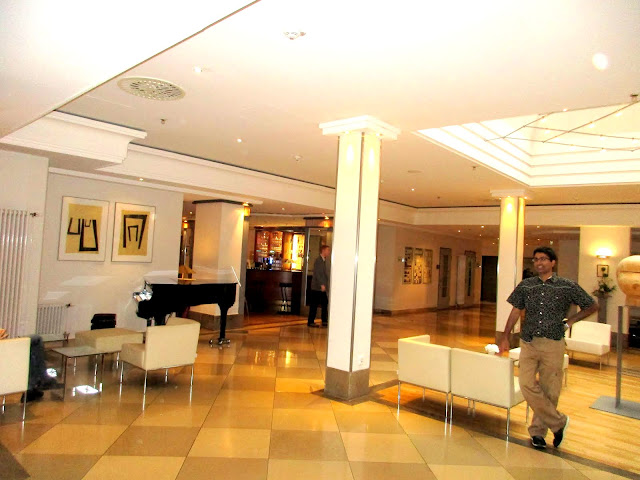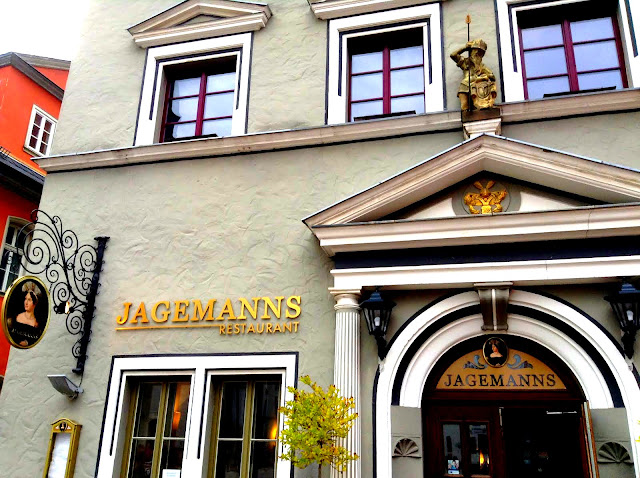Hotel Kaiserin Augusta, Weimar:
The office team had been put up in Hotel Kaiserin Augusta,
Kaiserin Augusta was the last German empress and so associated with the glorious past.
The hotel has some lovely antique furniture
The view from the room is nice ... fall colors in bahnhof platz
Oct 7, 2015 :
Son was off for training with the office team and I started
the day on my own.
Bought provisions at Lidl, 750 m from the hotel/bahnhof.
Then
started off on the walk through Classical Weimar.




The buildings have distinct decorative features and it's a pleasure to observe.




The buildings have distinct decorative features and it's a pleasure to observe.
Had a very pleasant stroll around the Markt square, where
every building has a story.

This is the Neptune fountain.
Great spot for a quiet read, ha, ha!

This is the Neptune fountain.
Goethe and Schiller had a remarkable friendship and
collaboration that was "like no other known to literature or art."
Both men had lived in Weimar , and
were the seminal figures of a literary movement known as Weimar Classicism.
This is Cranach’s early Renaissance house facing the neo-Gothic town
hall, whose tinkling bells are made of Meissen
porcelain. Cranach was a renaissance painter 1472-1553.
This is the oldest hotel Elephant
This 16th-century Hof-apotheke is where Martin Luther, the Protestant Reformer, picked up his prescriptions. While in town, he ate “like a Bohemian” and drank “like a German”!!

475-year-old Zum Schwarzen Bären, also on the square.


This seems to be an astronomical clock...
This is the oldest hotel Elephant
This 16th-century Hof-apotheke is where Martin Luther, the Protestant Reformer, picked up his prescriptions. While in town, he ate “like a Bohemian” and drank “like a German”!!

475-year-old Zum Schwarzen Bären, also on the square.


This seems to be an astronomical clock...
Even a van sports the famous half timber frame
Even the busker is classy...an elderly gentleman on his violin
Frogs are ubiquitous... probably prince in waiting?
Self explanatory signs on shop facades...
NOT Written in stone!! Written on wood rather... Menu card on a wood bark

Souvenirs
The ever present frog prince again...waiting for his kiss...
mmm... here's an interesting bookend!
An interesting chair...too much glare from the shop window...
A card welcoming a baby...
Scherenschnitte, which means "scissor cuts" in
German, is the art of paper cutting. The art work often has symmetry
within the design, and common forms include silhouettes.... (ready-made
patterns and basic cutting kits, an Exacto knife are available for the non
artists to try out this art)


Cardboard vehicles...
Lovely wood carvings


Terrific miniatures

Sail boat
Bird houses
Weather houses...
Delicate ceramics
Halloween stuff...(All Saints' Eve, is a yearly celebration observed in a number of countries on 31 October)
Plenty of stuff for older girls too... brides are attended to here...
Doughnut in the sun flowers in a bakery window...
Garden on a platter...
Interesting planter... ha, ha
Zum Zweibel...The Onion...Weimar has a thriving onion market
Quirky statue(s)... man buried in sand
St. Peter und Paul church: The first church was built on the
same location from 1245 to 1249, but destroyed by fire in 1299. Only the
foundations remain. The second building was badly damaged in the 1424 town
fire. The present building dates back to 1498
This is Johann Gottfried von Herder (1744 –1803), a German
philosopher, Herder attached exceptional importance to the concept of
nationality and of patriotism –
Herderplatz
This is the Mother's Love statue at the Donndorf fountain in
Weimar — Donndorf is another illustrious native of Weimar .


A standing draped female figure combining common iconic representations of Charity and of Temperance holds an infant and empties a ewer with her left hand, aided by a boy
The original sculpture was made by Donndorf in 1876, and was
placed in 1891 on Union Square
in New York .
There are many other fountains ...
This is the famous Neptune fountain...



Swan knight fountain here...
There are many other fountains ...
This is the famous Neptune fountain...



Swan knight fountain here...
This is Wittumspalais - the Widow's Palace. Built in 1767, it was the home of the Dowager
Duchess Anna Amalia and was, during Goethe's time, the epicenter of social and
literary activity in the city. Now a museum, this splendid two-winged palace
features fine décor, period furniture, and portraits of the Ducal family and
courtesans, as well as portraits of Goethe and Schiller in the Poet's Room.
Also of interest is the Round Table Room where guests like Goethe were
entertained, and did the entertaining.
It was an entertaining walk through the town. When son came
back in the evening we covered some portions till it became dark.




Oct 8, 2015 :
In the morning after a lovely breakfast we again raced
through the beautiful streets till it was time for son to leave for his
training. He sprinted back before 8.30 am
and caught up his van just when it was about to leave the hotel.
We had planned to take the afternoon train to Gotha
and we managed to do so and even see the palace there for the day. I’m covering
that in the next post:
http://adventuretrav.blogspot.com/2016/10/germany-trip-report-day-11-gotha.html
http://adventuretrav.blogspot.com/2016/10/germany-trip-report-day-11-gotha.html













































































































































This comment has been removed by a blog administrator.
ReplyDeleteSpam advertising by James Olik has been deleted.
ReplyDelete